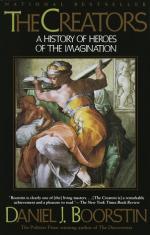
|
| Name: _________________________ | Period: ___________________ |
This test consists of 5 multiple choice questions, 5 short answer questions, and 10 short essay questions.
Multiple Choice Questions
1. When did Montaigne publish his Essays?
(a) 1580.
(b) 1620.
(c) 1825.
(d) 1607.
2. Whom does Boorstin say was the first biographer?
(a) James Boswell.
(b) Shakespeare.
(c) Benjamin Franklin.
(d) Dr. Samuel Johnson.
3. How does Boorstin characterize "The Love Song of J. Alfred Prufrock"?
(a) The first post-modern poem.
(b) The first confessional poem.
(c) The last Medieval chanson.
(d) The first modernist poem.
4. What does Boorstin say does the artist's job in photography?
(a) The developer.
(b) The machine.
(c) Light.
(d) The image itself.
5. For what does Boorstin say skyscrapers were first used?
(a) Commerce.
(b) Industry.
(c) Defense.
(d) Advertising.
Short Answer Questions
1. When did Goethe finish Faust?
2. What was the relationship between Wordsworth and Coleridge?
3. With what does Boorstin say Alfred Stieglitz experimented?
4. What did William Henry Fox Talbot discover?
5. What does Boorstin say artists began to see in modern art?
Short Essay Questions
1. How does Boorstin characterize Dickens' contribution to imaginative culture?
2. How did painting begin to reflect the changes that were taking place in literature?
3. What does Boorstin say is Ben Franklin's contribution to the art of imaginative life?
4. What does Boorstin say Pickering and Prescott have in common, and what is their role in the development of the Western imaginative consciousness?
5. What is the skyscraper's role in the development of the human imagination?
6. What does Boorstin say is William Wordsworth's contribution to imaginative culture?
7. In what way did T. S. Eliot change the course of literature's evolution?
8. How did photography change the nature of art and representation in Boorstin's account?
9. How does Boorstin characterize Milton's contribution to imaginative culture?
10. How does Proust change the way we understand imagination in modern times?
|
This section contains 645 words (approx. 3 pages at 300 words per page) |

|




